During my recent trip to the Kenyan coast, I booked a Mombasa street food tour on the same day that I landed. When I arrive in a new country, local food is always on my mind. Mombasa is a coastal city known for its Swahili street food, and I was determined to try as much of it as possible. Swahili food draws from a fantastic blend of cultural influences, with Indian, Arabic, and East African food traditions shining through in the flavorful dishes. As it turns out, walking (and tuk-tuking) around Old Town Mombasa with a local was a perfect way to start the trip. I got a great intro to Mombasa street food, and as a bonus, a historical tour of the whole neighborhood.
How to book a street food tour in Mombasa
I booked my street food tour via African Food Trail. This small local company offers street food tours and other experiences in Mombasa, as well as the beach towns of Diani and Watamu.
I paid just under $40 for my tour, which ended up being private as there were no others signed up. My guide Halima gave me a fantastic tour covering both street food and Mombasa history. If you’re looking for any kind of Mombasa tour, including street food, history, or even nearby safaris, you can also reach out to her directly on WhatsApp at +254 714 158169.
Why a Mombasa street food tour was perfect for me as a solo female traveler
- It gave me a crash course on the neighborhood I was staying in. This made it easier to navigate by both foot and tuk-tuk for the remainder of my stay.
- The tour introduced me to foods that I might not have noticed/tried on my own. I expanded my palate, and knew what to look for during future street food escapades!
- I got to try taster portions of everything rather than having to commit to big portions as a single person.
- It introduced me to vendors who I might have been too shy to start conversations with otherwise. This gave me deeper insight and appreciation into the foods and their makers.
Between the tour and my next few days in the city, I tried out plenty of Mombasa street foods. Here are some of the street foods to look for if you want the full culinary experience in Mombasa!
Savory street food bites and snacks
Mombasa has no shortage of savory street foods. Some are toothsome enough to constitute full meals (shawarma, falafel) while others are squarely in the snack category (viazi karai, cassava crisps). Many of the Mombasa street food offerings are fried, and can often be found from the same vendor. Often, one vendor will set up shop with their boiling oil and prepare a variety of snacks. This creates a perfect opportunity to craft your own variety plate for the ultimate street food experience.
Samosa
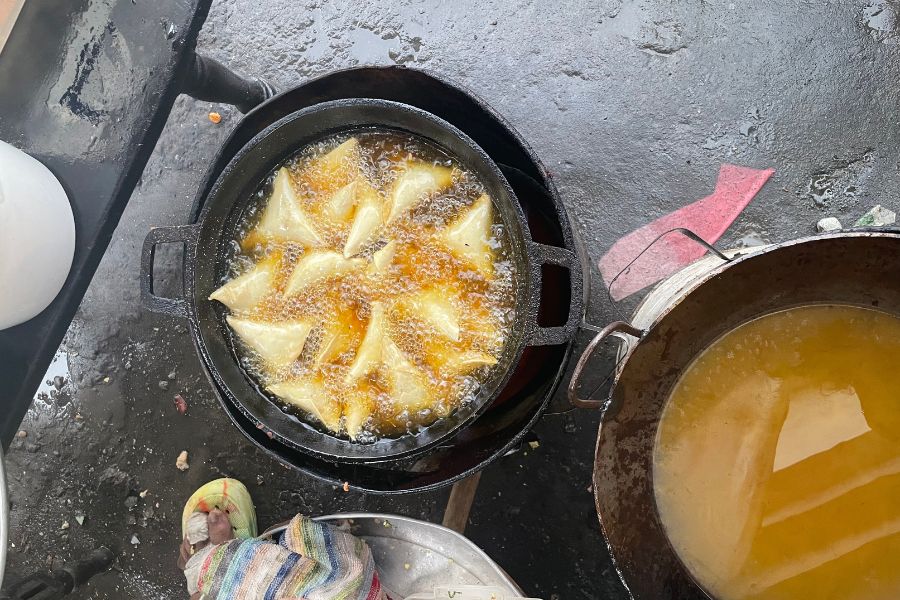
These ubiquitous savory pastries are made from thin sheets of dough which are wrapped into triangles around fillings, then deep-fried. Samosa fillings may include veggies (particularly spiced potatoes), or meats (chicken, beef, etc.). Delicious sauces such as tamarind, coconut, chili, or even just a simple squeeze of lime often accompany the samosas. If you’re vegetarian, be sure to communicate this the vendor. Veggie samosas are often available, and are a great vegetarian-friendly street food snack!
Falafel
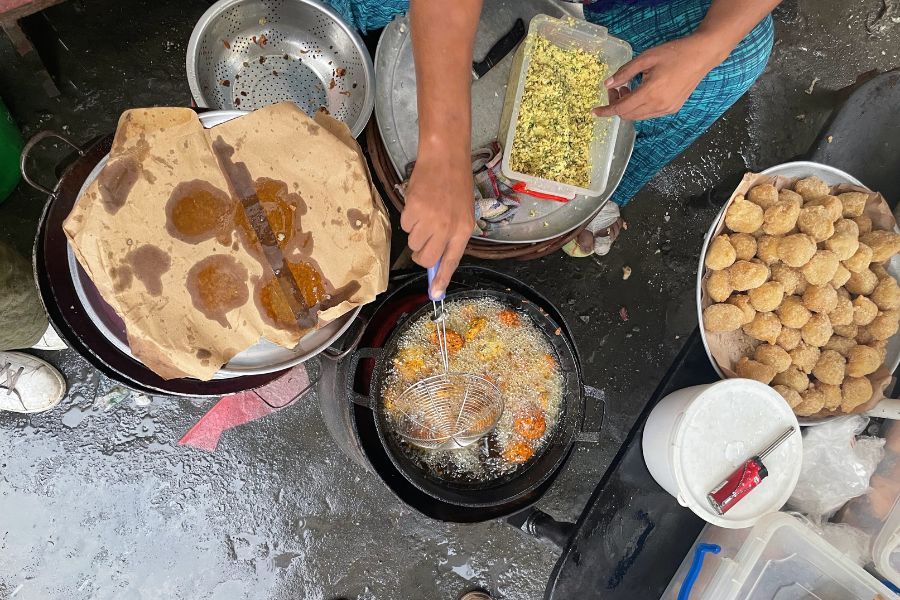
Falafels aren’t strictly a Kenya-only specialty, but the falafels you’ll find on the Mombasa streets are absolutely delicious. Falafels are made from ground legumes (often chickpeas) flavored with various aromatics and spices before being deep fried. The falafels I had in Mombasa were so much more moist and flavorful than other falafels I’ve had recently that it almost felt like a whole different food! These are also served with tasty homemade sauces, and make a fantastic vegetarian snack or quick lunch.
Viazi karai
I’m convinced that every culture has its own version of fried potatoes. Swahili food is no exception, and Viazi Karai is the Mombasa street food answer to this international phenomenon. To make Viazi Karai, vendors chop boiled potatoes into chunks, and then toss them in either a spiced flour mix or batter before, you guessed it, deep frying them. Some stalls will offer a slightly spicy option where they add a layer of chili powder. These addictive fried potatoes also come with the classic fried snack sauces, and are so wonderfully snackable.
Bhajia
Bhajia are light, fluffy fried balls made from a lentil and veggie dough. While you might imagine that anything with lentils would be rather dense, Bhajia will surprise you. These dumplings are delicious on their own or dipped in any of the fried snack sauces that usually accompany them.
Nyama choma
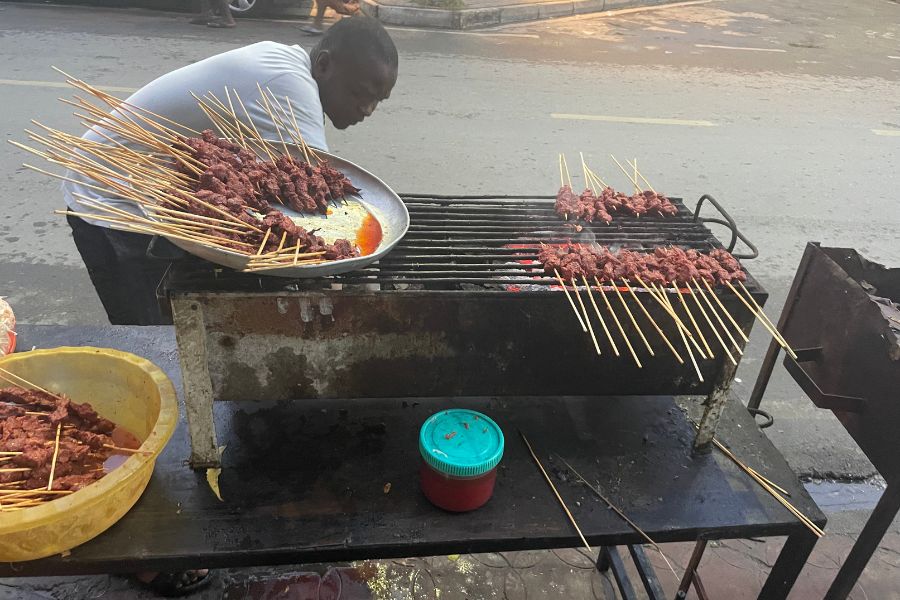
Nyama choma were described to me as the unofficial food of Mombasa – they are ubiquitous and beloved on the streets. These small skewers of bite-sized chunks of meat are marinated and then grilled streetside. I tried both beef and chicken nyama choma and I loved the deep flavor in the meat. As with all street meat, use your best judgment. I didn’t have digestive problems with any of the street foods I tried in Mombasa, but everyone is different!
Shawarma
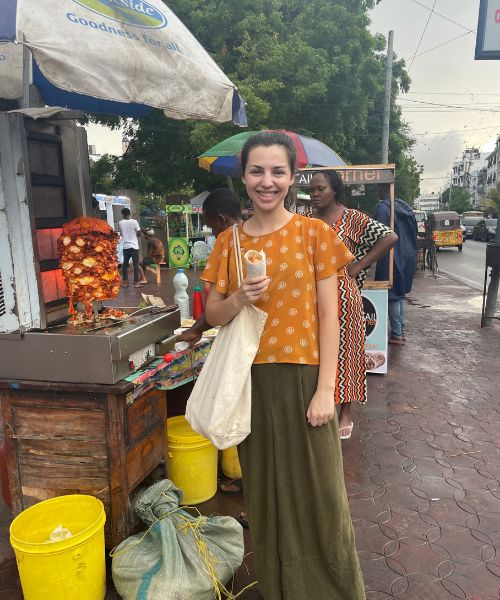
Shawarma is another one of those foods which isn’t specific to Mombasa, but is so delicious and easy to find that you shouldn’t leave without buying one. On the Mombasa streets, vendors shave large towers of rotating, cooking meat into small flatbreads with a few veggies and sauces to make a perfect shawarma. I tried a chicken shawarma and not only was it extremely tasty, it was also small enough to allow me to try a few other bites in the area. This was a huge win as a solo traveler trying to taste everything!
Casava crisps
Casava crisps are a sensory delight and a perfect companion to a wander through the Mombasa streets. To make cassava crisps, vendors shave fresh cassava roots into thin rounds over a boiling pot of oil. The oil quickly crisps the cassava rounds into crunchy chips, which the vendor fishes out of the oil and into bags for waiting customers. Salt, chili, and lime are popular toppings for the chips. I highly recommend chili and lime for extra flavor. The taste is similar to potato chips, so even the pickiest of eaters might enjoy tasting a cassava crisp!
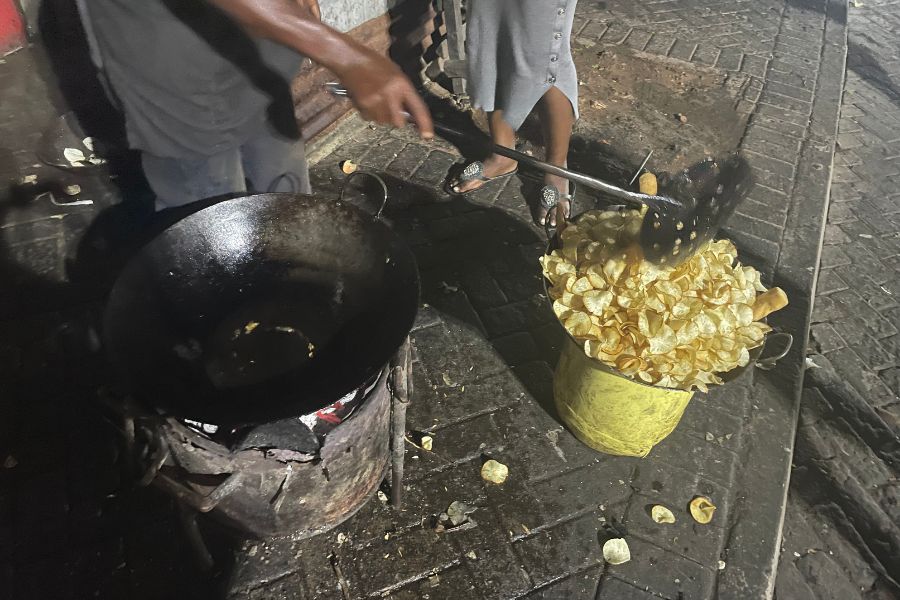
Chapati
Chapati is one of the main starch side dishes of Swahili cuisine. They are soft, chewy, thin flatbreads made from wheat flour and cooked on a hot griddle. While chapati isn’t strictly a street food, I saw plenty of folks bringing their griddles into the street to cook up chapati for hungry folks. Even if you can’t find a chapati on the street, pretty much any restaurant serving up Swahili food will be able to offer you a chapati alongside your meal. They are simple, delicious, and beloved, so you can’t leave Mombasa without eating some chapati.
Street Drinks
Sugar cane juice
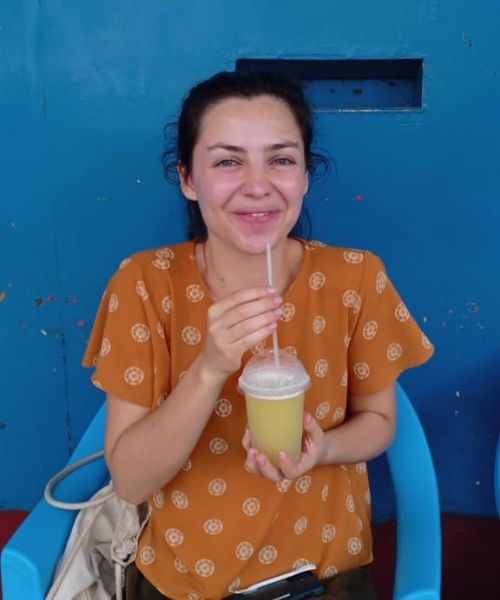
Before Mombasa, I’d had sugar cane juice exactly once: a $7 cup of juice from a tiny shop in Boston. It was fine, definitely not worth $7, and didn’t make me jump at the opportunity to consume more sugar cane juice. However, this perception couldn’t have been more wrong. Mombasa street food sugar cane juice is a transcendent beverage. Vendors feed fresh sugar cane through a press machine over an ice block, and add ginger, mint, and lime at request. At ~$1 for 500 ml, sugar cane juice was my lifeline in the Mombasa heat.
Fresh coconut water
If sugarcane juice isn’t cutting your thirst, luckily you have other refreshing options. Plenty of street vendors in Mombasa sell fresh coconuts which they will hack open for you, allowing you to drink the sweet coconut water inside. Pro tip: if you’re looking for a drink/snack combo, you can usually ask the vendor to split the coconut open for you after you’re done drinking. This will reveal scoopable coconut flesh inside for a little energy boost!
Swahili coffee
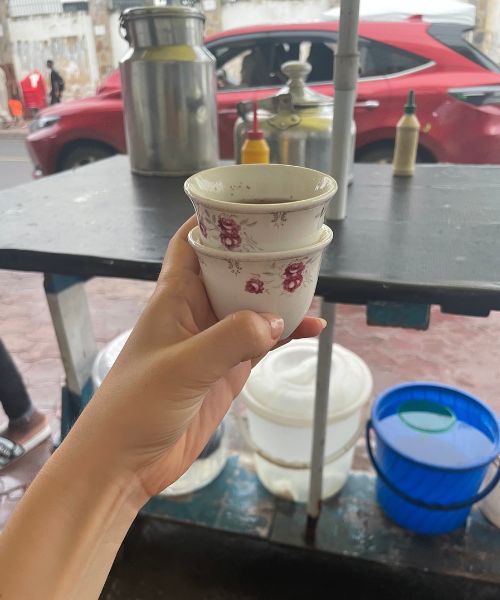
On the Mombasa streets and in traditional cafes you can find Swahili coffee just about everywhere. I tried Swahili coffee in two different styles: sweetened and unsweetened. The coffee is served in tiny bowl-shaped cups, often printed with flowers. The sweetened version was almost syrupy in its sweetness, with plenty of warming spices (ginger, cardamom, and more). The unsweetened version tastes akin to more traditional black coffee. I was there during Ramadan, and the kind man who sold me the coffee told me that he loves to have the unsweetened version with a date to break his fast. He tracked down some dates for me to try them together, and it was indeed an excellent combination
Chai
Milky, spiced chai is ubiquitous not just as a Mombasa street food (or drink), but also on every cafe menu. The combo of black tea, milk, and warming spices is served piping hot. Sometimes it is already sweetened, and sometimes it is served with sugar on the side for you to add. I was told that Kenyans like to drink chai in the morning, while they save their coffee consumption for later in the day/night. In my book, any time of the day was a good time for chai in Mombasa.
Street Food Sweets
Mandazi
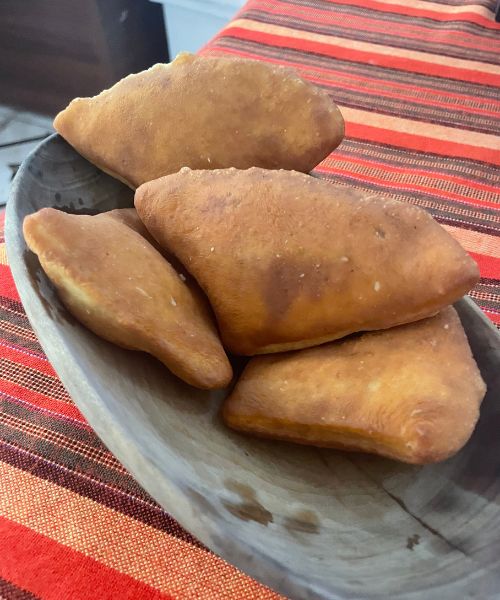
If you’re wandering the Mombasa streets and see little brown, puffy triangles, it’s time to make a pit stop for mandazi. Mandazi are pillowy, not-too-sweet donuts with coconut milk and cardamom in coastal Kenya. If you go inland, you might find Mandazi being made without the coconut/cardamom flavors, and I have to admit, it’s not quite as exciting as the Mombasa version. Mandazi are best enjoyed hot out of the oil, and make a fantastic morning snack.
Mitai
Why limit yourself to just one type of fried dough? If you’re looking for something slightly sweeter than mandazi, track down some mitai. Vendors toss these little fried dough dollops in granulated sugar, a departure from unadorned mandazi. This leaves you with an addictive crunchy coating, making these morsels oh-so-satisfying to snack on.
Mkate wa tambi
My guide introduced mkate wa tabmi to me as simply “Swahili bread”. This dense cake is made from vermicelli noodles, with coconut milk as a star flavoring ingredient. The resulting squares of mkate wa tambi are toothsome and sweet (but as with all of these desserts, not too sweet). I usually eat vermicelli noodles in a more savory setting, so this was a fun and unexpected bite in Mombasa
While this is just the tip of the iceberg when it comes to fantastic Swahili cuisine, these dishes are a great introduction to Mombasa street food. There’s no better way to soak in the unique culture and hospitality of this coastal city than to indulge in its food. Whether you’re looking for savory snacks, refreshing (or caffeinated) drinks, or something sweet, the Mombasa streets won’t leave you disappointed. Let me know which foods I need to try next time I make it back to the Kenyan coast!

Great description and photos and got me wanting to go to Mombasa
Food seems to be the heart of many places. I could almost feel the relief of the sugar cane drink on a hot sticky day.
Thank you for walking me through the streets of Mombasa.
Cheers
Pingback: How to Spend a Weekend in Old Town Mombasa, Kenya